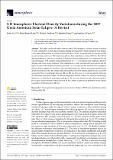| dc.contributor.author | Aa, Ercha | |
| dc.contributor.author | Zhang, Shun-Rong | |
| dc.contributor.author | Erickson, Philip J. | |
| dc.contributor.author | Wang, Wenbin | |
| dc.contributor.author | Coster, Anthea J. | |
| dc.date.accessioned | 2023-09-27T20:05:50Z | |
| dc.date.available | 2023-09-27T20:05:50Z | |
| dc.date.issued | 2023-08-31 | |
| dc.identifier.uri | https://hdl.handle.net/1721.1/152282 | |
| dc.description.abstract | This paper studies the three-dimensional (3-D) ionospheric electron density variation over the continental US and adjacent regions during the August 2017 Great American Solar Eclipse event, using Millstone Hill incoherent scatter radar observations, ionosonde data, the Swarm satellite measurements, and a new TEC-based ionospheric data assimilation system (TIDAS). The TIDAS data assimilation system can reconstruct a 3-D electron density distribution over continental US and adjacent regions, with a spatial–temporal resolution of 1<inline-formula><math xmlns="http://www.w3.org/1998/Math/MathML" display="inline"><semantics><msup><mrow></mrow><mo>∘</mo></msup></semantics></math></inline-formula>× 1<inline-formula><math xmlns="http://www.w3.org/1998/Math/MathML" display="inline"><semantics><msup><mrow></mrow><mo>∘</mo></msup></semantics></math></inline-formula> in latitude and longitude, 20 km in altitude, and 5 min in universal time. The combination of multi-instrumental observations and the high-resolution TIDAS data assimilation products can well represent the dynamic 3-D ionospheric electron density response to the solar eclipse, providing important altitude information and fine-scale details. Results show that the eclipse-induced ionospheric electron density depletion can exceed 50% around the F2-layer peak height between 200 and 300 km. The recovery of electron density following the maximum depletion exhibits an altitude-dependent feature, with lower altitudes exhibiting a faster recovery than the F2 peak region and above. The recovery feature was also characterized by a post-eclipse electron density enhancement of 15–30%, which is particularly prominent in the topside ionosphere at altitudes above 300 km. | en_US |
| dc.publisher | Multidisciplinary Digital Publishing Institute | en_US |
| dc.relation.isversionof | http://dx.doi.org/10.3390/atmos14091379 | en_US |
| dc.rights | Creative Commons Attribution | en_US |
| dc.rights.uri | https://creativecommons.org/licenses/by/4.0/ | en_US |
| dc.source | Multidisciplinary Digital Publishing Institute | en_US |
| dc.title | 3-D Ionospheric Electron Density Variations during the 2017 Great American Solar Eclipse: A Revisit | en_US |
| dc.type | Article | en_US |
| dc.identifier.citation | Atmosphere 14 (9): 1379 (2023) | en_US |
| dc.contributor.department | Haystack Observatory | |
| dc.identifier.mitlicense | PUBLISHER_CC | |
| dc.eprint.version | Final published version | en_US |
| dc.type.uri | http://purl.org/eprint/type/JournalArticle | en_US |
| eprint.status | http://purl.org/eprint/status/PeerReviewed | en_US |
| dc.date.updated | 2023-09-27T12:35:59Z | |
| dspace.date.submission | 2023-09-27T12:35:59Z | |
| mit.license | PUBLISHER_CC | |
| mit.metadata.status | Authority Work and Publication Information Needed | en_US |
